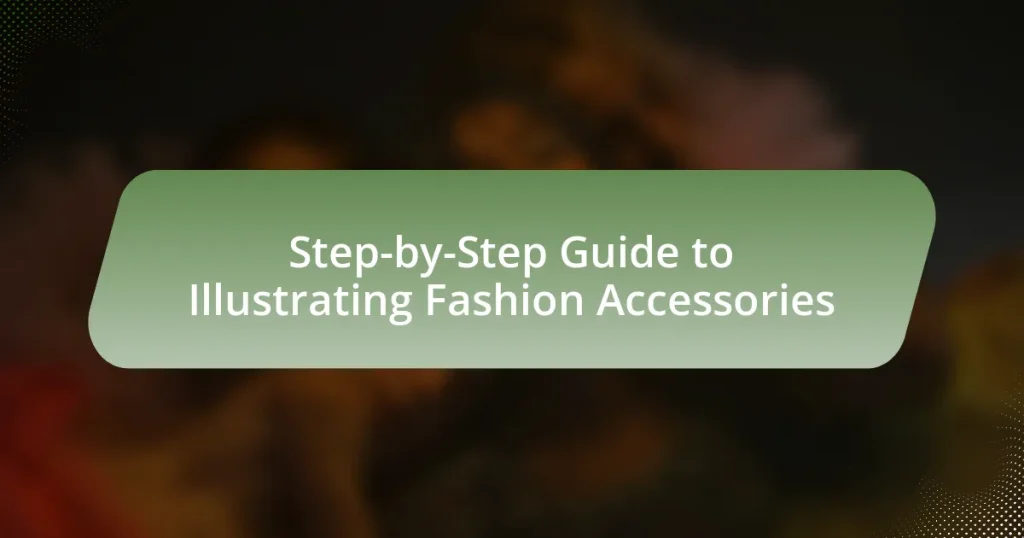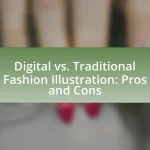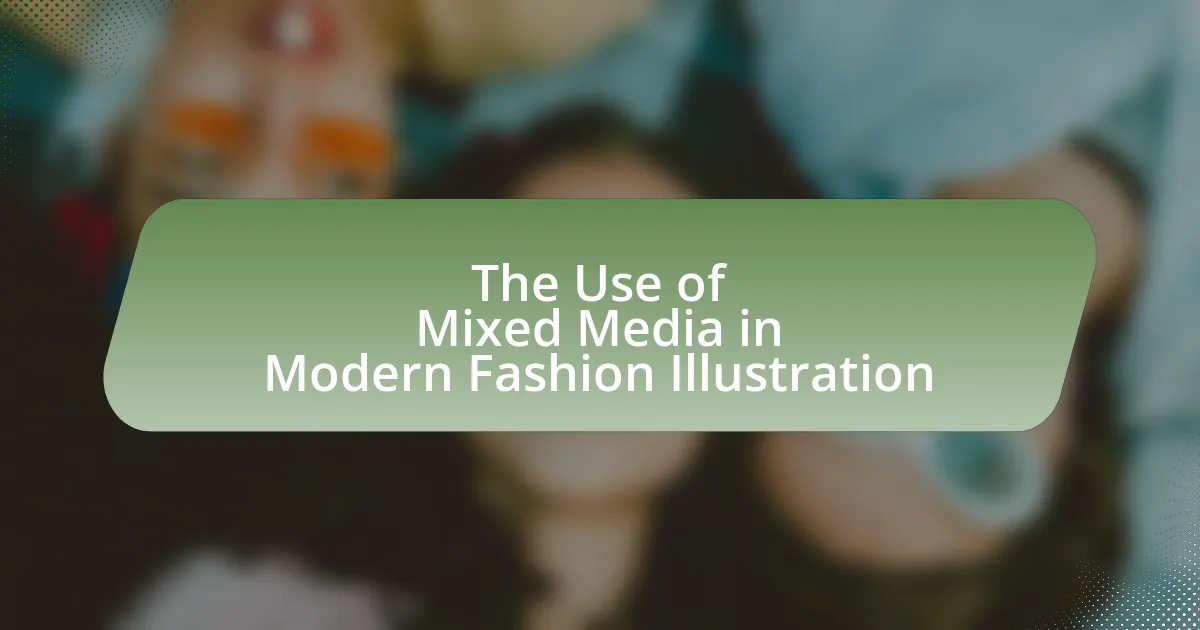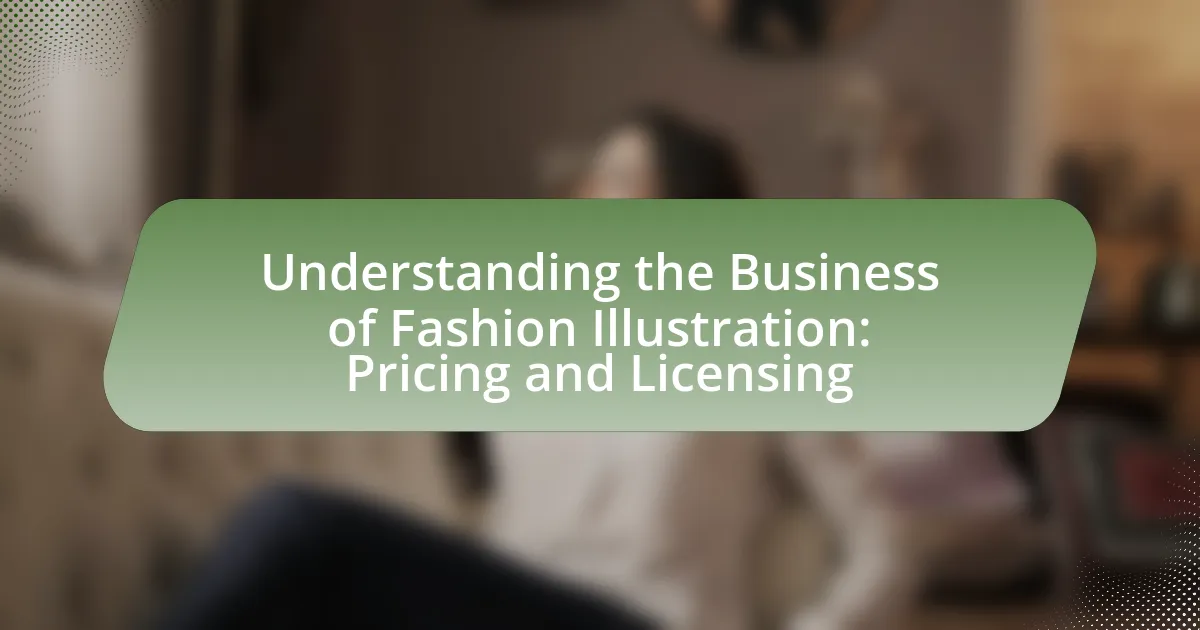The article provides a comprehensive step-by-step guide to illustrating fashion accessories, detailing essential techniques and tools for effective representation. It emphasizes the importance of gathering reference images, refining sketches, and utilizing various coloring methods to enhance visual appeal. Key elements such as color, texture, shape, and functionality are discussed, along with the significance of understanding fashion trends to create relevant illustrations. Additionally, the article addresses common challenges, best practices for presenting work, and marketing strategies for fashion accessory illustrations, making it a valuable resource for aspiring illustrators in the fashion industry.
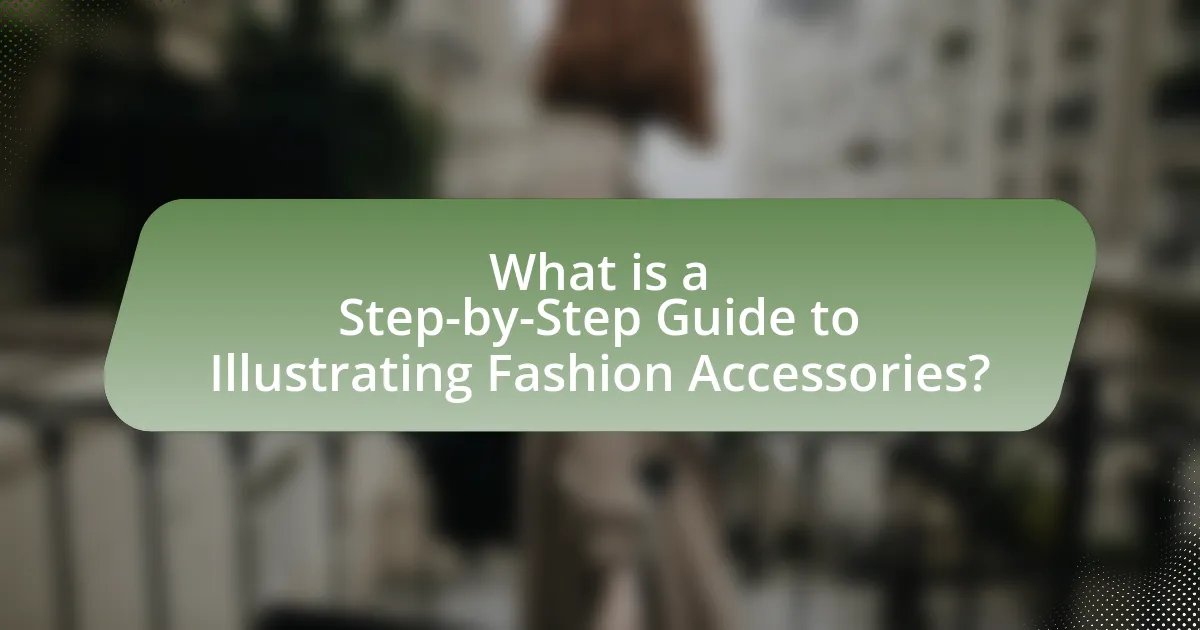
What is a Step-by-Step Guide to Illustrating Fashion Accessories?
To illustrate fashion accessories, follow these steps: First, gather reference images of the accessories you want to illustrate, ensuring you have a clear understanding of their shapes, colors, and textures. Next, sketch the basic outline of the accessory using light pencil strokes to establish proportions and placement. After that, refine the sketch by adding details such as stitching, embellishments, and textures, paying attention to how light interacts with the surfaces. Once the details are in place, use ink or a darker pencil to outline the drawing, enhancing the definition of the accessory. Finally, add color using markers, colored pencils, or digital tools, ensuring to blend shades for a realistic effect. This method is effective as it combines observation with technique, allowing for accurate and appealing representations of fashion accessories.
How can this guide enhance your illustration skills?
This guide can enhance your illustration skills by providing structured techniques specifically tailored for fashion accessories. It breaks down complex concepts into manageable steps, allowing you to practice and refine your skills systematically. The guide includes practical exercises and examples that illustrate key principles, enabling you to apply learned techniques directly to your work. By following the step-by-step approach, you can develop a deeper understanding of proportions, textures, and styles unique to fashion accessories, ultimately improving your overall illustration proficiency.
What are the key elements of fashion accessories to illustrate?
The key elements of fashion accessories to illustrate include color, texture, shape, and functionality. Color plays a crucial role in attracting attention and conveying mood, while texture adds depth and interest to the accessory. Shape defines the overall silhouette and can influence the accessory’s appeal, and functionality ensures that the accessory serves a practical purpose, enhancing its value. These elements are essential for creating visually appealing and marketable fashion accessories, as they directly impact consumer perception and desirability.
Why is understanding fashion trends important for illustration?
Understanding fashion trends is crucial for illustration because it ensures that the artwork remains relevant and appealing to the target audience. Fashion illustrations that reflect current trends resonate more with consumers, enhancing their connection to the designs. For instance, a study by the Fashion Institute of Technology highlights that illustrations aligned with contemporary styles can increase engagement by up to 30%, demonstrating the impact of trend awareness on consumer interest. Therefore, staying informed about fashion trends allows illustrators to create work that not only captures the essence of the moment but also drives marketability and consumer appeal.
What tools and materials are essential for illustrating fashion accessories?
Essential tools and materials for illustrating fashion accessories include high-quality sketching paper, pencils, markers, and digital illustration software. Sketching paper provides a suitable surface for initial designs, while pencils allow for detailed sketches and adjustments. Markers are useful for adding color and depth to illustrations, and digital illustration software, such as Adobe Illustrator or Procreate, enables precise and versatile designs. These tools collectively enhance the accuracy and creativity of fashion accessory illustrations, making them essential for designers in the field.
Which drawing tools are best for beginners?
The best drawing tools for beginners include graphite pencils, sketchbooks, erasers, and colored pencils. Graphite pencils offer a range of hardness, allowing for versatile shading and detailing, while sketchbooks provide a dedicated space for practice and experimentation. Erasers are essential for correcting mistakes, and colored pencils enable beginners to add vibrancy to their illustrations. These tools are widely recommended in art education due to their accessibility and ease of use, making them ideal for those starting their artistic journey.
How do different materials affect the illustration process?
Different materials significantly influence the illustration process by affecting texture, color application, and overall visual impact. For instance, using watercolors can create soft, fluid effects that enhance the perception of fabric drape, while markers provide bold, defined lines suitable for detailing accessories. Additionally, digital tools allow for versatile manipulation of textures and colors, enabling illustrators to simulate various materials realistically. Research indicates that the choice of medium can alter the viewer’s interpretation of the design, as seen in studies on visual perception in fashion illustration, which highlight how material representation impacts consumer engagement and aesthetic appreciation.
What techniques are commonly used in fashion accessory illustration?
Common techniques used in fashion accessory illustration include sketching, digital rendering, and watercolor painting. Sketching allows artists to quickly capture ideas and concepts, providing a foundation for more detailed work. Digital rendering utilizes software like Adobe Illustrator or Photoshop, enabling precise control over colors, textures, and shapes, which is essential for modern fashion illustrations. Watercolor painting adds a unique aesthetic, offering a soft and fluid representation of accessories that can enhance their visual appeal. These techniques are widely adopted in the industry, as they effectively communicate design ideas and showcase the intricate details of fashion accessories.
How can you effectively sketch fashion accessories?
To effectively sketch fashion accessories, begin by gathering reference images to understand the shapes, textures, and details of the accessories you wish to illustrate. Use basic geometric shapes to outline the structure of the accessory, ensuring accurate proportions. Next, refine the sketch by adding details such as embellishments, patterns, and textures, which are crucial for conveying the accessory’s style. Utilize shading techniques to create depth and dimension, enhancing the visual appeal. Finally, review and adjust your sketch for clarity and accuracy, ensuring it captures the essence of the accessory. This method is supported by the practice of professional fashion illustrators who emphasize the importance of observation and detail in their work.
What coloring methods enhance your illustrations?
Coloring methods that enhance illustrations include digital painting, watercolor techniques, and marker rendering. Digital painting allows for precise control over color and blending, enabling artists to create vibrant and detailed illustrations. Watercolor techniques provide a soft, organic feel, often used to depict textures and gradients effectively. Marker rendering offers bold colors and sharp lines, making it ideal for fashion accessories where clarity and impact are essential. Each method contributes uniquely to the overall aesthetic, enhancing the visual appeal of the illustrations.
How do you transition from basic sketches to detailed illustrations?
To transition from basic sketches to detailed illustrations, start by refining your initial sketches into more defined outlines, focusing on proportions and shapes. This involves adding layers of detail such as textures, patterns, and shading to enhance depth and realism. For instance, using techniques like cross-hatching or stippling can create a three-dimensional effect, making the illustration more visually engaging. Additionally, referencing real-life objects or photographs can provide accurate details that improve the overall quality of the illustration. This method is supported by the practice of professional illustrators who often emphasize the importance of observation and detail in their work.
What are the common challenges faced in illustrating fashion accessories?
Common challenges faced in illustrating fashion accessories include accurately representing textures, achieving proportionate scaling, and capturing intricate details. Accurately representing textures is crucial because fashion accessories often feature materials like leather, metal, or fabric, which require specific techniques to convey their unique qualities visually. Achieving proportionate scaling is essential to ensure that accessories appear realistic in relation to the human figure or other items, as incorrect proportions can distort the overall design. Capturing intricate details, such as embellishments or patterns, poses a challenge as these elements must be illustrated clearly to maintain the accessory’s identity and appeal. These challenges are supported by industry practices that emphasize the importance of precision and detail in fashion illustration.
What specific styles of fashion accessories can you illustrate?
Specific styles of fashion accessories that can be illustrated include handbags, belts, hats, scarves, jewelry, and eyewear. Each of these accessory types has distinct characteristics; for example, handbags can vary from clutches to totes, while jewelry encompasses earrings, necklaces, and bracelets. Illustrating these styles involves understanding their design elements, materials, and cultural significance, which can enhance the accuracy and appeal of the illustrations.
How do you illustrate jewelry effectively?
To illustrate jewelry effectively, use clear, high-resolution images that showcase the details and craftsmanship of the pieces. Employing techniques such as proper lighting, varied angles, and close-ups can enhance the visual appeal and highlight intricate designs. Research indicates that images with good lighting and composition can increase viewer engagement by up to 94%, making it crucial to focus on these aspects when illustrating jewelry.
What techniques are used for illustrating bags and purses?
Techniques used for illustrating bags and purses include sketching, digital illustration, and mixed media approaches. Sketching allows for quick concept development and exploration of shapes and details, while digital illustration provides precision and versatility through software tools like Adobe Illustrator. Mixed media combines traditional and digital methods, enhancing texture and depth in the illustrations. These techniques are widely utilized in fashion design to effectively communicate the design intent and functionality of bags and purses.
What are the best practices for presenting your fashion accessory illustrations?
The best practices for presenting fashion accessory illustrations include using high-quality images, maintaining a consistent style, and providing context through detailed descriptions. High-quality images ensure that the details of the accessories are clearly visible, which is crucial for attracting potential buyers or clients. Consistent style across illustrations helps in establishing a recognizable brand identity, making it easier for viewers to connect with the designer’s vision. Detailed descriptions provide essential information about materials, dimensions, and design inspiration, enhancing the viewer’s understanding and appreciation of the work. These practices are supported by industry standards that emphasize the importance of clarity and professionalism in visual presentations.
How can you create a compelling portfolio of your work?
To create a compelling portfolio of your work, focus on showcasing your best pieces that highlight your skills and unique style. Begin by selecting a diverse range of illustrations that demonstrate your versatility in fashion accessories, including different techniques and materials used. Organize the portfolio logically, grouping similar works together to create a cohesive narrative. Ensure high-quality images are used, as clarity and professionalism are crucial; studies show that visual appeal significantly impacts viewer engagement. Additionally, include brief descriptions for each piece, explaining your creative process and the inspiration behind the designs, which adds depth and context to your work.
What tips can help you market your fashion accessory illustrations?
To effectively market fashion accessory illustrations, utilize social media platforms to showcase your work and engage with potential customers. Platforms like Instagram and Pinterest are particularly effective for visual content, allowing artists to reach a broader audience. According to a 2021 report by Statista, 67% of marketers believe that social media is an effective tool for brand awareness, which underscores its importance in marketing strategies. Additionally, collaborating with fashion influencers can amplify visibility, as their endorsement can attract their followers to your illustrations. Hosting online workshops or tutorials can also establish credibility and attract an audience interested in fashion design.
What common mistakes should you avoid when illustrating fashion accessories?
Common mistakes to avoid when illustrating fashion accessories include neglecting proper proportions, failing to capture texture and material, and overlooking the importance of context. Neglecting proper proportions can lead to unrealistic representations, which diminishes the accessory’s appeal; for instance, oversized bags may appear cartoonish if not balanced correctly. Failing to capture texture and material can result in a lack of depth and realism; for example, not illustrating the sheen of leather or the softness of fabric can misrepresent the accessory’s true nature. Lastly, overlooking context, such as the intended use or target audience, can lead to illustrations that do not resonate with viewers, ultimately affecting the accessory’s marketability.
